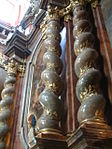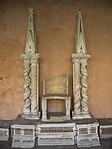Solomonic column

The Solomonic column, also called barley-sugar column, is a helical column, characterized by a spiraling twisting shaft like a corkscrew. It is not associated with a specific classical order, although most examples have Corinthian or Composite capitals. But it may be crowned with any design, for example, making a Roman Doric solomonic or Ionic solomonic column.[1]
Perhaps originating in the
Etymology and origin


Unlike the classical example of
In the 4th century,
Some of these columns remained on the altar until the old structure of St. Peter's was torn down in the 16th century. While removed from the altar, eight of these columns remain part of the structure of St. Peter's. Two columns were placed below the pendentives on each of the four piers beneath the dome. Another column can now be observed up close in the St. Peter's Treasury Museum. Other columns from this set of twelve have been lost over the course of time.
If these columns really were from one of the Temples in Jerusalem, the spiral pattern may have represented the oak tree which was the first Ark of the Covenant, mentioned in Joshua 24:26.[3] These columns have sections of twist-fluting alternating with wide bands of foliated reliefs.
From Byzantine examples, the Solomonic column passed to Western Romanesque architecture. In Romanesque architecture some columns also featured spiraling elements twisted round each other like hawser. Such variety adding life to an arcade is combined with Cosmatesque spiralling inlays in the cloister of St. John Lateran. These arcades were prominent in Rome and may have influenced the baroque Solomonic column.
In Baroque architecture

The Solomonic column was revived as a feature of
Easily the best-known Solomonic columns are the colossal bronze
, which was finished in 1633, required that the original ones of Constantine be moved.During the succeeding century, Solomonic columns were commonly used in altars, furniture, and other parts of design. Sculpted vines were sometimes carved into the spiralling cavetto of the twisting columns, or made of metal, such as gilt bronze. In an ecclesiastical context such ornament may be read as symbolic of the wine used in the Eucharist.
In the 16th century
Peter Paul Rubens employed Solomonic columns in tapestry designs, ca 1626 [1], where he provided a variant of an Ionic capital for the columns as Raphael had done, and rusticated and Solomonic columns appear in the architecture of his paintings with such consistency and in such variety that Anthony Blunt thought is would be pointless to give a complete list.[5]
The columns became popular in
After 1660, such twist-turned columns became a familiar feature in the legs of French, Dutch and English furniture, and on the glazed doors that protected the dials of late 17th- and early 18th-century bracket and longcase clocks. English collectors and dealers sometimes call these twist-turned members "barley sugar twists" after the type of sweet traditionally sold in this shape.
Gallery
-
Solomonic columns and other fanciful variants in the cloister ofSt John Lateran, Rome, early 13th century
-
Pompey in the Temple of Jerusalem by Jean Fouquet, 1470–1475
-
Raphael's workshop's Donation of Constantine shows St. Peter's Solomonic columns in their original location in front of the altar in the old basilica
-
Papal throne from the cloister ofSt. John Lateran
-
Renaissance design of a candlestick in form of an Ionic Solomonic column, circa 1530-1546
-
Renaissance door to the staircase of the Hôtel d'Assézat, Toulouse (France), 1555-1556.
-
Print by François Boucher, in which appears a pair of Solomonic columns with Ionic capitals
See also
References
- ^ Craven, Jackie (December 1, 2017). "What Is a Solomonic Column?". ThoughtCo. Retrieved 2018-05-24.
- ^ a b c Ward-Perkins, J. (1952). "The shrine of St. Peter's and its twelve spiral columns". Journal of Roman Studies. 42. p. 21ff.
- ^ a b Durman, Richard (September 2002). "Spiral Columns in Salisbury Cathedral" (PDF). Ecclesiology Today (29): 26–35. Archived from the original on 2006-02-25.
- ISBN 978-0-500-20361-3.
[They] seem to float unsupported
- ^ a b Blunt, Anthony (September 1977). "Rubens and Architecture". The Burlington Magazine. Vol. 119, no. 894. pp. 609–619 [613 note 19].
External links
- Two of the columns as presently used in St. Peter's
- Raphael's Healing of the Lame Man, tapestry cartoon, 1515–16
- Rubens' The Gathering of Manna, oil sketch for tapestry, ca. 1626, for a tapestry at the Convent of the Descalzas Reales, Madrid








